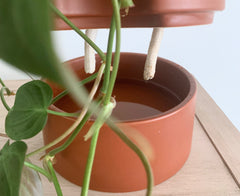We Tested A Self-Watering Houseplant Pot: Here’s How & Why to Use Them

Watering plants is the most popular topic that houseplant parents ask about– especially since over and under-watering are two of the biggest concerns for potted plants. If you’ve ever tried a self-watering planter, you know that this handy invention can take the guesswork out of watering frequency and amount. Or maybe you consider yourself a beginner or not-so-good with keeping to a plant watering schedule. All of these are great reasons to look into a self-watering pot; which could just be your secret key to plant success. It’s not only chic, but functional too!
What is a Self-Watering Pot

With a self-watering planter, the plant is provided with constant, but consistently accurate access to water in order to survive. There are different types of pots that utilize various mechanisms to create this self-sufficient system. One of the most reliable self-watering pots uses the wicking method. Through capillary action, water-wicking planters use (typically) rope to draw water from a reservoir to the soil and roots. Making the process of caring for a plant super seamless, water-wicking reservoirs can be refilled about once every month (or less depending on the season and type of plant)!
How It Works
Here, Figure 1 shows water being filled into the bottom reservoir. Figure 2 depicts the wicking material which sits directly in the water below.


Which Plants are Compatible
It’s important to note though that self-watering pots are not recommended for all types of houseplants. The plants that work best with these planters are your easy to moderate houseplants– the ones we’d associate with being more self-sufficient or resilient. Plants that require a lot of water or are more finicky may not be suitable for an independent process. For example, certain tropical houseplants like Calathea need to stay constantly damp throughout the soil. Since the wicking method generally pulls water from the bottom, the top portion of the soil stays pretty dry. So the Calathea genus wouldn’t flourish with water-wicking systems. On the other end of the spectrum, succulents generally like the soil to dry out nearly completely before supplying more water– so your Cactus is not going to love a self-watering planter. So what thrives? Plants that want the top inch or two of soil drying out will benefit immensely from a self-watering system. And luckily, a wide range of houseplants enjoy drying out a bit between normal, human-conducted waterings– that includes Alocasia, Pothos, Scindapsus, Philodendron, Hoya, Monstera, Rhaphidophora, Syngonium, and Ficus (just to name a few). And they may just do better with a self-watering planter (see below!).
Pro Tip: Water the plant from the top-down about once every couple of months to ensure that the top portion of the roots stay healthy.

Case Study: Self-Watering Pots Produce More Growth
We at Outside In tested the Self-Watering Pot with a Philodendron Micans. As you can see in the progress pictures (below), we started with 2 six-inch plants. One (the control) was kept in the standard nursery pot and watered by hand once it was partially dry (about once a week). The other (the test) was potted directly into the wicking pot and the bottom reservoir was refilled with water every 2-4 weeks. Both plants were given similar environmental exposure to sunlight, temperature, and humidity. The results were astounding!
About the Pot
For this self-conducted study, we used a high-quality, ceramic planter (same one in the photos). This planter uses cotton rope to wick water upwards from a saucer at the base of the pot. This saucer is considerably larger than other self-watering pots’ water reservoirs– thus allowing more water to be held at any given time, and more time between refilling. The planter is 6” in diameter and 7” in height.


The Results
The results? Well, over 3 months, the Micans in the self-watering pot had grown exponentially compared to the control plant– at least twice the size! This showed that the self-watering pot was a success– of course considering controlling for other factors like preferable living conditions.
When testing the self-watering pot, we didn’t set out to achieve these results. Actually, we just wanted to know whether the pot worked. We hypothesized that the pot would be a viable option for the plant. And our hypothesis was accurate– but even more so, the findings were surprisingly satisfying with the pot providing such prosperous effects.
So why was the self-watering pot so much more successful than a regular pot? While we can’t with absolute confidence ascertain an exact reason, we believe that a few factors contributed to the success of the plant in self-watering planter. One of those being that the self-watering planter reduces the chance of human error (e.g., less chance to miss a watering or overwater). Also, potted plants are sometimes at a disadvantage compared to plants in the ground, where they can draw moisture from the soil naturally. The self-watering pot allows the plant to take water when it needs while still supplied with ample drainage to not oversaturate.
Pro Tip: As with any potted plant, it’s helpful to make sure the soil doesn’t become compacted over time. This should be less of a problem with a self-watering planter since water isn’t forcing downward pressure on the soil. But either way, simply aerating the soil by poking (with chopsticks or something similar) a few times a year can be helpful.
Who Benefits
We know that self-watering pots rely on the plant to decide when and how much water it needs. This not only keeps the plant happy and healthy, but it is also a sustainable practice helping conserve water. In addition, this system benefits so many people that have or want houseplants– including those looking to give a seamless gift, frequent travelers, or even busy parents who need minimal effort plants. While beginners can gain more confidence with plants, those more experienced can free up time with the use of self-watering planters.